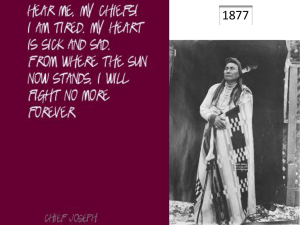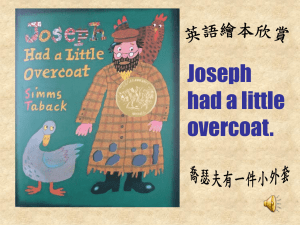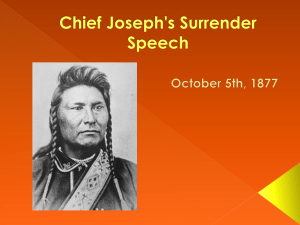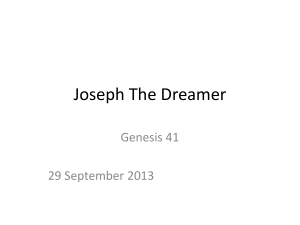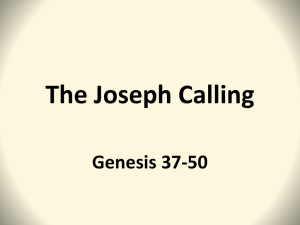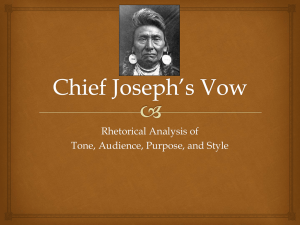JS0899 - Mormon Polygamy Documents
advertisement
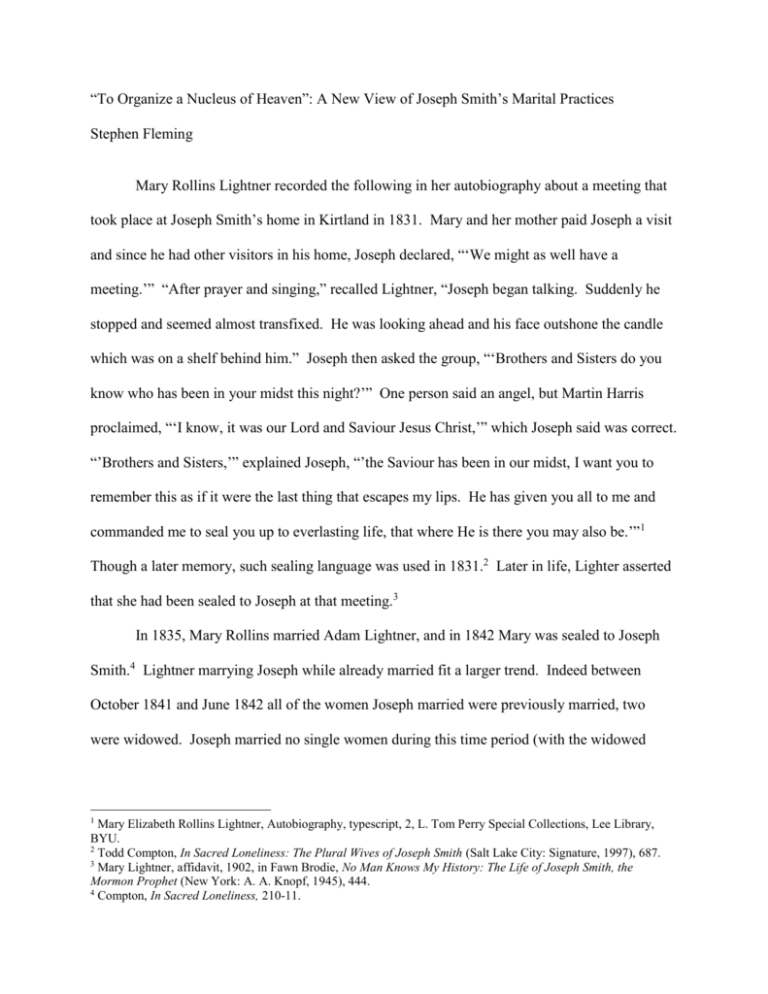
“To Organize a Nucleus of Heaven”: A New View of Joseph Smith’s Marital Practices Stephen Fleming Mary Rollins Lightner recorded the following in her autobiography about a meeting that took place at Joseph Smith’s home in Kirtland in 1831. Mary and her mother paid Joseph a visit and since he had other visitors in his home, Joseph declared, “‘We might as well have a meeting.’” “After prayer and singing,” recalled Lightner, “Joseph began talking. Suddenly he stopped and seemed almost transfixed. He was looking ahead and his face outshone the candle which was on a shelf behind him.” Joseph then asked the group, “‘Brothers and Sisters do you know who has been in your midst this night?’” One person said an angel, but Martin Harris proclaimed, “‘I know, it was our Lord and Saviour Jesus Christ,’” which Joseph said was correct. “’Brothers and Sisters,’” explained Joseph, “’the Saviour has been in our midst, I want you to remember this as if it were the last thing that escapes my lips. He has given you all to me and commanded me to seal you up to everlasting life, that where He is there you may also be.’”1 Though a later memory, such sealing language was used in 1831.2 Later in life, Lighter asserted that she had been sealed to Joseph at that meeting.3 In 1835, Mary Rollins married Adam Lightner, and in 1842 Mary was sealed to Joseph Smith.4 Lightner marrying Joseph while already married fit a larger trend. Indeed between October 1841 and June 1842 all of the women Joseph married were previously married, two were widowed. Joseph married no single women during this time period (with the widowed 1 Mary Elizabeth Rollins Lightner, Autobiography, typescript, 2, L. Tom Perry Special Collections, Lee Library, BYU. 2 Todd Compton, In Sacred Loneliness: The Plural Wives of Joseph Smith (Salt Lake City: Signature, 1997), 687. 3 Mary Lightner, affidavit, 1902, in Fawn Brodie, No Man Knows My History: The Life of Joseph Smith, the Mormon Prophet (New York: A. A. Knopf, 1945), 444. 4 Compton, In Sacred Loneliness, 210-11. women still having a potential eternal spouse in their deceased husbands).5 Though the practice of marrying married women is often seen as an anomaly, it also was a clear trend for this period. I argue here that Joseph’s practice of marrying married women was a deliberate one of binding loved ones together for the purpose expressed by Joseph to Mary Lightner in 1831. Indeed Joseph used similar language to Lightner when he proposed to her in 1842: “I know I shall be saved in the Kingdom of God. I have the oath of God upon it and God cannot lie. All that he gives me I shall take with me for I have that authority and that power conferred upon me.”6 A statement by Benjamin F. Johnson many years later, I believe, best describes what Joseph was trying to accomplish: “The Prophet taught us that Dominion & powr in the great future would be Comensurate with the no [number] of ‘Wives Childin & Friends’ that we inheret here and that our great mission to earth was to Organize a Neculi [nucleus] of Heaven to take with us.”7 Joseph sought to bind his loved ones—“wives, children, and friends”—to him in this world in order to prepare for the next. Including “friends” in addition to “wives and children” suggests that Joseph sought to be sealed not only to women, not only to single women, not only to family members, but to all those to whom he felt especially connected; sealing marriage to women was Joseph’s method of doing so. I argue that from fall 1841 to summer 1842 Smith was engaged in what I call “composite marriage”: interlocking relationships where both men and women could be sealed to multiple spouses. All this was done, I argue, for the purpose of forming a nucleus, or perhaps nuclei, of heaven. The marital status of Joseph’s wives followed a pattern. He married Fanny Alger around 1833 (a young single woman) and then married Louisa Beaman (another young single woman) in 5 Compton, In Sacred Loneliness, 4. Mary Lightner, The Testimony of Mary Lightner, BYU Devotional 1905, pamphlet compiled and edited by David Dye (Hindsight Publications, n.d.), 26. 7 Dean R. Zimmerman, I Knew the Prophets: An Analysis of the Letter of Benjamin F. Johnson to George F. Gibbs (Bountiful, Utah: Horizon, 1976), 47. 6 2 1840. Starting with Zina Huntington, he began to marry married women from October 1841 to summer 1842 (I consider the date of Lucinda Harris’s marriage to be uncertain). From spring 1843, his wives were almost all single, just one was married (and Elvira Cowles Holmes may have married Joseph previously). Thus Joseph followed a general pattern from single to married to single.8 The median age of Joseph’s wives between fall 1841 and summer 1842 was 32; the median age of Joseph’s wives from spring to summer of 1843 was 19.9 None of the married women that Smith married left their original husbands during Joseph’s lifetime and Joseph may have had the consent of some of the husbands.10 Marinda Hyde was sealed to both Joseph and Orson Hyde.11 Joseph reportedly proposed to Nancy Rigdon, a single woman, in the spring of 1842, but John C. Bennett (the first to make the report) said that Joseph told Nancy that his proposed marriage “would not prevent her from marrying any other person.”12 In 1880, Mary Rollins Lightner wrote to Emmeline Wells, “I could tell you why I stayed with Mr. Lightner. Things the leaders of the Church does not know anything about. I did just as Joseph told me to do, as he knew what troubles I would have to contend with.”13 Lightner’s claim in 1880 that her remaining with her first husband constituted “things the leaders of the Church does not know about” suggests that Joseph’s practice of marrying married women was one that made the leaders of the Church uncomfortable at that time, and one they tried to forget (it is unlikely that John Taylor did not know of the practice, Wilford Woodruff and George Q. Cannon said that Joseph had asked to marry Taylor’s wife).14 Rumors emerged in Utah of a practice of proxy husbands, that women could have children with proxy husbands 8 Fawn Brodie noted a similar pattern but did not explore the implications. Brodie, No Man Knows by History, 337. Compton, In Sacred Loneliness, 4, 756. 10 Todd Compton thinks that, in particular, Henry Jacobs and Windsor Lyon may have known. Compton, In Sacred Loneliness, 81, 179. 11 Compton, In Sacred Loneliness, 238, 243. 12 “The Mormons,” Sangamo Journal (Springfield, Ill.), July 15, 1842. 13 Quoted in Compton, In Sacred Loneliness, 213. 14 John M. Whitaker, “Daily Journal of John M. Whitaker,” typescript, 251, Perry Special Collections. 9 3 while their husband were away on lengthy missions. But as Lawrence Foster points out, there is no evidence of such things actually occurring;15 furthermore, proxy husbands does not fit Joseph’s marital practices. Brian Hales notes that many Mormons in Utah condemned polyandry, but these condemnations do not constitute proof that Joseph did not practice it. Hales rightly notes that polyandry would have been contrary to Joseph’s followers’ traditional beliefs,16 but as Joseph taught in 1843, “To becom a joint heir of the heirship of the son [a believer] must put away all his traditions.”17 Joseph’s marital pattern shifted sometime between the summer of 1842 and the spring of 1843, to only polygyny (discussed below). The revelation explaining this new system, Doctrine and Covenants section 132, made reference to the former system (composite marriage). Verse 41 states, “And as ye have asked concerning adultery, verily, verily, I say unto you, if a man receiveth a wife in the new and everlasting covenant, and if she be with another man, and I have not appointed unto her by the holy anointing, she hath committed adultery and shall be destroyed.”18 Thus a wife received in the new and everlasting covenant may be with another man if the Lord appoints her to the union “by the holy anointing.” In 1842, John C. Bennett described the Mormon sealing ordinance as follows: “I now anoint you with holy, consecrated oil, in the name of Jesus Christ, and by the authority of the holy priesthood, that you may be fully and unreservedly consecrated to each other and to the service of God, and that with affection and fidelity you may nourish and cherish each other, as long as you shall continue faithful and true in 15 Lawrence Foster, Religion and Sexuality: Three American Communal Experiments of the Nineteenth Century (New York: Oxford University Press, 1981), 163-66. 16 Brian C. Hales, “Joseph Smith and the Puzzlement of ‘Polyandry,’” in The Persistence of Polygamy: Joseph Smith and the Origins of Mormon Polygamy, ed. Newell G. Bringhurst and Craig L. Foster (Independence, Mo.: John Whitmer, 2010), 119-20. Hales and a number of later Utah commenters noted that the biblical precedent for polygyny was lacking for polyandry. But biblical precedence was also lacking for eternal marriage, a practice that many Mormons readily accepted nonetheless. 17 Ehat and Cook, Words of Joseph Smith, 244, Aug 27, 1843. 18 Doctrine and Covenants 132:41. 4 the fellowship of the Saints.”19 As Lawrence Foster notes, the language of the ordinance is very similar to the revelation that Joseph gave at the time of his marriage to Sarah Ann Whitney.20 What is important in Bennett’s description is the mention of anointing with consecrated oil, which suggests that the phrase “appointed unto her by the holy anointing” is a reference to marital sealing. Thus the revelation states that a man could receive “a wife in the new and everlasting covenant” and that wife could have another husband “appointed unto her by the holy anointing”: that is, the sealing ordinance. The sexuality of Joseph’s marriages has been much debated, but boiling Joseph’s marital relationships down to sex misses the point.21 The point of the marriages, again, was best described by Mary Lightner, both in her description of the 1831 “sealing” and in the proposal to her by Joseph: to be united with Joseph so as to go with him into the Father’s kingdom. This was something that many of the saints wanted. Oliver Huntington said that “soon after Dimick had given our sisters Zina & Prescinda to Joseph as wives for eternity,” Joseph offered Dimick any reward he wanted. Dimick requested “that where you and your fathers family are, there I and my fathers family may also be.”22 Todd Compton argues that a number of polyandrous husbands may have known about the sealing, particularly Henry Jacobs and Windsor Lyon.23 In 1890, at an anniversary party for John Taylor, Wilford Woodruff and George Q. Cannon said that Joseph had asked to marry John Taylor’s wife, that it was a sore trial for Taylor but he consented, and that Joseph then told him it was just a test (this is similar to the story Orson F. Whitney told about his grandfather Heber. C. Kimball, discussed below.) Woodruff 19 John C. Bennett, History of the Saints, or, an Expose of Joe Smith and Mormonism (Boston: Leland and Whiting, 1842), 224. 20 Foster, Religion and Sexuality, 172. 21 There is evidence for some sexuality in Joseph’s marriages and I do not find the claims that he did not have sex with his married wives compelling. Compton, In Sacred Loneliness, 12-15. 22 Quoted in Compton, In Sacred Loneliness, 122-23. 23 Compton, In Sacred Loneliness, 81, 179. 5 and Cannon then described Taylor’s relationship with the Prophet, shedding light on why Taylor might have consented. “President Taylor was one of the most devout, loyal, and Trustworthy persons the Prophet ever had save his Brother Hyrum,” asserted Woodruff and Cannon, “he loved him and offered his life for him at Carthage…. At the Family Reunions he often told his family How he loved the Prophet, and also said there is no love in the world equal to the Love I had to Joseph Smith, how I loved that man, it was a different kind of love, surpassing any love for a woman.”24 Thus the tremendous love and devotion that many of his followers had for Joseph would have been the catalyst for their consenting to Joseph marring their wives, sex or no sex. According to Samuel Brown, “Ritual marriages would unite worshippers as part of the celestial plurality of Smith's heaven family.” Brown calls this blueprint “the sacerdotal family” and interprets DC 132:17 in this light: “In [Joseph’s] polygamy revelation,” argues Brown, “Smith warned that, if individuals could not be brought into the sacredotal family, they could not be saved; they would instead live ‘separately and singly,’ without exaltation.” Brown argues that in a speech given four days Joseph “emphasized that those who failed to participate in the sacredotal family through polygamy would ‘never becom[e] Sons of God,’ an explicit equation of adoption and polygamy.”25 Thus it was through marriage that the saints were adopted into Joseph’s sacerdotal family and could achieve exaltation. At the same time, it would be a mistake to think that Joseph’s wives were simply connectors between Joseph and their husbands. According to Mary Lightner, “Joseph Said I was John M. Whitaker, “Daily Journal of John M. Whitaker,” typescript, 1:251, November 1, 1890, Perry Special Collections. 25 Samuel M. Brown, “Early Mormon Adoption Theology and the Mechanics of Salvation,” Journal of Mormon History 37, no. 3 (2011): 38-39. 24 6 his, before I came here. He said all the Devils in Hell should never get me from him.”26 After Mary was sealed to Joseph, her husband moved her fifteen-miles up the river from Nauvoo: “The Prophet felt very sad when he knew we were going to leave,” said Lightner, “and with tears running down his cheeks he prophesied that if we left the Church we would have plenty of sorrow.”27 Both of these statements suggest that Joseph felt a deep attachment to Lightner, and that he wanted her nearby. Again the purpose of the sealings was to be bound together in the Father’s kingdom for eternity. Sealing marriage seems to have been the means to create this great union, this “nucleus of heaven.” In 1843, John C. Bennett asserted that Joseph taught that because individuals could not marry in heaven, “It has been revealed to him that there will be no harmony in heaven unless the Saints select their companions and marry IN TIME, FOR ETERNITY!!! They must marry in time so as to begin to form the sincere attachment and unsophisticated affection which is so necessary to consummate in eternity in order to the peace of Heaven.”28 This statement from Bennett is in accordance with Benjamin Johnson’s assertion: “That our great mission to earth was to Organize a Neculi [nucleus] of Heaven to take with us.”29 Bennett’s statement also sheds light on Joseph’s reaction to Lightner moving up the river: the goal of the sealing unions was to form earthly attachments that would persist in the next life. Having those attachments broken, even by fifteen miles, was extremely painful for Joseph. Therefore, the sealing marriages were the means of enacting what Mary Lightner had recalled from the meeting at Joseph’s house in 1831: they were ordinances that would bind Joseph’s special loved one to him for time and all eternity. Again, Joseph sought to be sealed not only to women, not only to single women, not only to family members, but all those to whom he 26 Lightner, Affidavit, 444. Mary Elizabeth Rollins Lightner, Autobiography, typescript, 9, Perry Special Collections. 28 “Letter from Gen. Bennett,” in Hawk Eye (Burlington, Iowa: December 7, 1843) in Compton, In Sacred Loneliness, 636. 29 Zimmerman, I Knew the Prophets, 47. 27 7 felt especially connected. Martial sealings were the means by which Joseph sought to enact this fundamental and eternal desire. Sexual relations with his polyandrous wives would not have violated this desired union any more than sexual relations with his polygynous wives would have violated those unions. While all of the instances of shared wives were with Joseph, there were rumors about Joseph suggesting that Emma should take a second husband.30 Verse 51 of the revelation on polygyny states, “Verily, I say unto you: A commandment I give unto mine handmaid, Emma Smith, your wife, whom I have given unto you, that she stay herself and partake not of that which I commanded you to offer unto her; for I did it, saith the Lord, to prove you all, as I did Abraham, and that I might require an offering at your hand, by covenant and sacrifice.”31 What Emma had been offered by Joseph that she was now not to partake of could have been anything, but this revelation is about plural marriage and thus it would be odd for the revelation to suddenly change the subject in regard to this verse. Most likely the verse suggests that the thing offered was another husband. But now the Lord says that she is not to have a union with another husband and that the Lord did this “to prove you all, as I did Abraham, and that I might require an offering at your hand, by covenant and sacrifice.” The wording suggests that the Lord had commanded Joseph to give Emma another husband but the Lord had now revoked the command. The task would not simply have been for Emma to have accepted Joseph’s plural wives since the revelation does not revoke that command. 30 Joseph H. Jackson, said Emma wanted William Law as a second husband. Adventures and Experience of Joseph H. Jackson: Disclosing the Depth and Villainy of Mormonism Practiced in Nauvoo (Warsaw, Ill.,1846), 21. But Jackson had a bad reputation and his account is very problematic: he said Smith told him all kinds of secret information even though he was not a Mormon and said that he continually denounced Smith to his face. (Law Rigdon 305 n. 26 Salt Lake Tribune, 3 July 1887). 31 Doctrine and Covenants 132:51. 8 The wording “you all” (rather than “you both”) suggests the challenge and its removal had been issued to multiple people. No doubt being asked to share one’s wife with Joseph would have been a challenge to husbands if they knew (many were indeed upset, discussed below). The story of Joseph asking John Taylor fits this pattern as does the story of Joseph making the same request to Heber C. Kimball, as told by his grandson Orson F. Whitney. Whitney said that before Joseph taught Heber about plural marriage, “He put him to a test which few men would have been able to bear. It was no less than a requirement for him to surrender his wife, his beloved Vilate, and give her to Joseph in marriage.” “Three days he fasted and wept and prayed,” said Whitney, “Then, with a broken and bleeding heart, but with a soul self-mastered for the sacrifice, he led his darling wife to the Prophet’s house and presented her to Joseph.” Whitney said that the act proved his faithfulness, “The will for the deed was taken, and ‘accounted unto him for righteousness.’” Heber held “back nothing,” but laid “all upon the altar for God’s glory.” Thus Whitney presented Heber as passing the Abrahamic test, and Heber was rewarded by being sealed to Vilate.32 Todd Compton dates this event as having occurred in early 1842, when Joseph was marrying married women.33 While the proposal fits the pattern, Joseph telling his married wives that his proposal was just a test does not; Joseph married a number of married women. Furthermore, there was an addendum to the story that Whitney mentioned almost as a side note: “Soon after the revelation was given a gold link was forged whereby the houses of Heber and Joseph were indissolubly and forever joined. Helen Mar, the eldest daughter of Heber Chase and Vilate Murray Kimball was given to the Prophet in the holy bonds of celestial 32 Orson F. Whitney, Life of Heber C. Kimball An Apostle: The Father and Founder of the British Mission (1888, reprint; Salt Lake City: Bookcraft, 1967), 323-24. 33 Compton, In Sacred Loneliness, 495. 9 marriage.”34 Helen’s account of her marriage to Joseph suggests that her story was linked to that of her father’s. In her 1881 autobiography, Helen stated, “Just previous to my father’s starting upon his last mission but one, to the Eastern States, he taught me the principle of Celestial marrage [sic], & and having a great desire to be connected with the Prophet, Joseph, he offered me to him; this I afterwards learned from the Prophet’s own mouth.” According to Helen, it was Heber who offered her to Joseph because he wanted to be connected to the Prophet. This brings up the question: if Heber wanted to be connected with the Prophet, why didn’t Joseph simply marry Vialte? Again, Joseph married a number of married women. Helen’s language also invokes that of the Abrahamic trial, similar to that of section 132:51: “My father had but one Ewe lamb, but willingly laid her upon the alter.”35 Might Helen have been a replacement for Vilate? Wilhelm Wyl, the anti-Mormon editor of the Salt Lake Tribune, in 1886 asserted that Helen was a replacement for Vilate.36 When asked about Wyl’s assertion, Helen responded that “the falsehoods furnished by Sarah M. Pratt about my father, mother, & myself are enough to damn her without any thing more.”37 Wyl put the matter in very negative terms, but Helen had used similar language in her autobiography five years earlier. Again, Orson Whitney said Joseph asked for Vilate and we know that Joseph was marrying married women at that time. Helen said that Joseph told her that Heber had promised Helen to Joseph. The two incidents could have been linked. The story of Heber and Helen Mar Kimball may provide a window into the shift of Joseph’s marital practices from married to single women: upset at the prospect of sharing wives, 34 Whitney, Life of Heber C. Kimball, 328. Hellen Mar Kimball Whitney, Autobiography, 1881, in Helen Mar Kimball Whitney, A Woman’s View: Helen Mar Whitney’s Reminiscences of Early Church History, ed. Jeni Broberg Holzapfel and Richard Neitzel Holzapfel (Provo, Utah: Religious Studies Center, Brigham Young University 1997), 482. 36 Wilhelm Wyl, Joseph the Prophet: His Family and Friends (Salt Lake City: Tribune, 1886), 71-72. 37 Helen Mar Kimball Whitney, A Widow’s Tale: the 1884-1896 Diary of Helen Mar Kimball Whitney, ed. Charles M. Hatch and Todd M. Compton (Logan: Utah State University Press, 2003), 183, Aug. 26, 1886. 35 10 Joseph’s inner circle may have preferred that he marry their daughters instead. In 1854, Jedediah Grant recalled what the early days of polygamy were like for Joseph’s followers in Nauvoo: “When the family organization was revealed from heaven—the patriarchal order of God, and Joseph began, on the right and on the left, to add to his family, what a quaking their was in Israel. Says one brother to another … “now suppose Joseph should come and say he wanted your wife, what would you say to that?’ ‘I would tell him to go to hell.’ This was the spirit of many in the early days of the Church.”38 Grant asserted that Joseph was asking for the wives of his followers and that telling Joseph “to go to hell… was the spirit of many in the early days.” Grant used the phrase “what a quaking there was in Israel” to describe the attitude. The despondency of Orson Pratt over the claims that Joseph had proposed to his wife Sarah, best demonstrates the “quaking in Israel” that Grant described. While the incident is controversial, Joseph proposing to Sarah Pratt fits the pattern of him proposing to many married women at that time.39 The controversy surrounding Joseph’s fallout with John C. Bennett, who placed the claims of Sarah Pratt at the center of his attack on Joseph, was likely the catalyst behind Joseph’s shift from marrying married to single women. Orson Pratt was despondent at the claim that Joseph had proposed to his wife, “My sorrows are greater than I can bear!” he wrote his wife, “Where I am henceforth it matters not.” Pratt turned dissenter for a time and Bennett’s disclosures were very bad press. In addition Joseph was forced to hide from Missouri extradition attempts at that time.40 On June 29th, 1842, Joseph married his first single wife since Louisa Beaman, Eliza R. Snow, indicating a change in Joseph’s marital practices. Furthermore, Joseph’s new marriages slowed considerably that summer; he only married four women between 38 Jedediah Grant, February 19, 1854, Journal of Discourses, 2:13. Richard S. Van Wagoner, “Sarah M. Pratt: The Shaping of an Apostate,” Dialogue 19, no. 2 (1986): 69-99. 40 Richard Bushman, Joseph Smith: Rough Stone Rolling (New York: Knopf, 2005), 466-72. 39 11 the summer of 1842 and the spring of 1843. After Eliza, Joseph’s next wife was Sarah Ann Whitney, his first teenage bride since Fanny Alger. After Sarah, Joseph’s next wife was Martha McBride Knight who was widowed and the next was Ruth Vose Sayers who was married.41 The median age for these women was 34, the mean was 29. The major change in Joseph’s marital pattern came in the spring of 1843 when he began marrying in earnest again. Joseph had reconciled with Orson Pratt and seemed to have regained his confidence. But now he was marrying almost all single women, who were, on the whole, considerably younger than his previous wives. Joseph married 14 women between spring and summer of 1843, all but one were single and most of them were young. The median age of the single women was 19.42 This was a very different pattern than the one of 1841-42, where the median age was 32. If Joseph could not marry married women, then he needed to marry women before they were married, which meant he needed to marry them at a younger age. The question is, which is preferable, young wives or married wives? Joseph is often criticized for both of these activities when in fact they did not occur simultaneously; they were the result of two different policies. Thus I argued that Joseph began the practice with Fanny Alger c. 1833, resumed the practice with Louisa Beaman and then switched to composite marriage. If a central purpose of polygamy was to bring people into Joseph’s sacerdotal family, then women being able to marry multiple men would work better for that purpose than would polygyny. The Bennett and Orson Pratt disasters of the summer of 1842 caused a change in the program, which resulted in a switch to younger single women. Yet Heber C. Kimball and the Whitney’s still sought to be bound to Joseph by having him marry their daughters. This linking would only work for those who had 41 42 Compton, In Sacred Loneliness, 4-6. Compton, In Sacred Loneliness, 6. 12 unmarried daughters, however, and it also caused Joseph to marry younger wives, very young in the case of Helen Mar Kimball. Polygyny was reified as the new policy, yet the evidence suggests that there had been two different policies. Elizabeth Lightner’s letter to Emmeline Wells is suggestive. “I could tell you why I stayed with Mr. Lightner. Things the leaders of the Church does not know anything about. I did just as Joseph told me to do.”43 There does seem to have been an attempt to forget the polyandrous marriages. It is unlikely that Brigham Young, Heber C. Kimball, or John Taylor did not know anything about the polyandrous marriages. More likely, after seeing the disaster of the summer of 1842, Joseph and his inner circle realized that composite marriage simply was not going to work and they therefore opted for a more pragmatic practice: polygyny. The attempt to live, failure to live, and rescinding of the law of consecration seems an apt comparison here. But what of the eternities? Did being sealed to Joseph mean losing one’s wife in the eternities? Many assume this, but D&C 132:41 suggests otherwise. Henry Jacobs, whose wife Zina married Joseph polyandrously and then married Brigham Young for time, remained hopeful of being united with Zina in the eternities. “Zina I have not forgotten you,” Henry wrote to her in 1846, “my Love is as ever the same and much more abundantly And hope that it will cont[in]ue to grow stronger an[d] stronger to all Eternity world without End.’” Further, stated Henry, in the eternities, “There will be shiftings in time and revisions”, “and all be mad[e] right in the End.’”44 The wording of Doctrine and Covenants 132:41 suggests that Henry has cause to be hopeful of being with Zina and her other husbands in the next life. In 1873, T. B. H. Stenhouse quoted a letter that said that during the Mormon Reformation, “It was hinted and secretly taught by authority that women should form relations 43 44 Quoted in Compton, In Sacred Loneliness, 213. Quoted in Compton, In Sacred Loneliness, 89. 13 with more than one man.” To this statement, Stenhouse added, “The Author has no personal knowledge from the present leaders of the Church, of this teaching; but he has often heard that something yet would be taught which ‘would test the brethren as much as polygamy had tried the sisters.’” Stenhouse said that “some elders” believed that this future teaching would be proxy husbands, but a practice that “would test the brethren as much as polygamy had tried the sisters” suggests something of a more eternal nature.45 I conclude with a statement from the Neoplatonic philosopher Proclus (413-485). In commenting on Plato’s dictum that in the ideal city wives would be shared,46 Proclus argued that such sharing was the nature of heaven. “Why ever should it be, then,” asserted Proclus, that this same principle is observed in the universe, but seems paradoxical when applied to human lives? Because, I shall claim, all human soul has been sliced off from the whole and become separate, and it is on this account that it finds doctrines that cling to the principle of sharing to be very hard to accept. But if one were to eliminate this lower standing and raise oneself back to the whole, then one would accept such a sharing, ignoring the divided communal feeling among the multitude. Insofar as each of us is drawn down towards the part and becomes isolated and deserts the unified whole, to that extent he is confined to the corresponding life, a life of ungoverned conditions.47 Like Joseph Smith, Proclus taught that it was through shared marriages that we could join the whole and avoid the fate of those angels who “did not abide [the Lord’s] law; therefore, they cannot be enlarged, but remain separately and singly, without exaltation.” (DC 132:17). 45 T. B. H. Stenhouse The Rocky Mountain Saints: A Full and Complete History of the Mormons (D. Appleton, 1873), 301. 46 In the Republic, Plato said that wives and children ought to be shared among the guardians of the city in order to preserve common cause among the leaders (Republic, 457-462). Plato repeated this notion in his Laws and most importantly his Timaeus, the most historically influential dialogue (Laws, 739c; Timaeus, 18c-d). 47 Proclus, Commentary on Plato’s Timaeus, trans. and ed. Harold Tarrant (Cambridge, Cambridge University Press, 2007)1:143. 14
![Title of the Presentation Line 1 [36pt Calibri bold blue] Title of the](http://s2.studylib.net/store/data/005409852_1-2c69abc1cad256ea71f53622460b4508-300x300.png)
